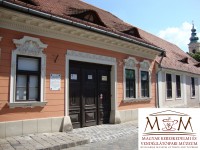A képen egy gazdagon díszített porcelán mosdótál és mosdókancsó látható a dunaparti Grand Hotel Hungáriából. A hotel földszintjén egykor Sárfy Lajos kávézója és Briher János luxusétterme működött, ahol nap mint nap Rácz Pali cigányzenekara játszott, aki leginkább amiatt lett később világhírű, mert Kálmán Imre róla mintázta a „Cigányprímás” című operett főhősét. A hotel (amely egy épülettömbben volt a Carlton és a Bristol szállókkal) súlyosan megsérült a II. világháborúban, helyére építették a Duna Intercontinentált 1970-ben.
További megnevezés: Magyar Kereskedelmi és Vendéglátóipari Múzeum látványraktára
en

